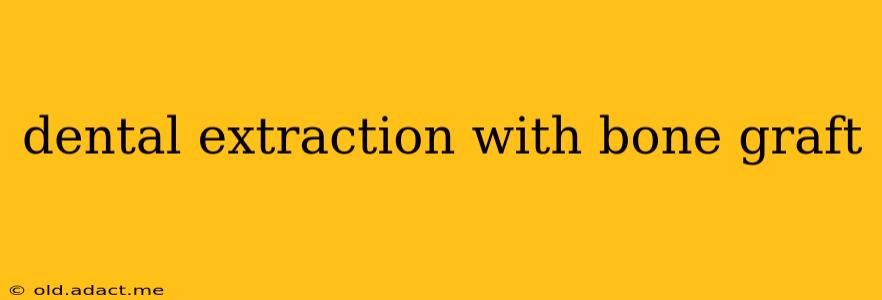Dental extractions, while sometimes unavoidable, can lead to bone loss in the jaw. This bone loss can complicate future dental procedures like implants. A bone graft, therefore, often accompanies extractions to preserve jawbone structure and ensure successful implant placement down the line. This comprehensive guide will explore the intricacies of dental extraction with a bone graft, addressing common questions and concerns.
What is a Bone Graft and Why is it Necessary After an Extraction?
A bone graft is a surgical procedure where bone tissue is taken from another part of your body (autograft), a donor (allograft), or a synthetic source (alloplast) and placed into the extraction site. This is crucial because after a tooth is extracted, the jawbone begins to resorb, or shrink, due to the lack of stimulation from the tooth root. This bone loss can significantly affect the stability and success of future dental implants. A bone graft helps maintain the jawbone volume, providing a strong foundation for implants or even preventing the need for extensive bone augmentation later.
What are the Different Types of Bone Grafts Used in Dental Procedures?
Several types of bone grafts are used, each with its own advantages and disadvantages:
- Autograft: Bone is harvested from another site in your own body, usually the chin or hip. This is considered the gold standard due to its high success rate and minimal risk of rejection. However, it involves a second surgical site and longer recovery time.
- Allograft: Bone is taken from a deceased donor. This eliminates the need for a second surgical site but carries a slightly higher risk of disease transmission, although this risk is extremely low with modern processing techniques.
- Xenograft: Bone is sourced from another species, usually cows. This is less commonly used now compared to autografts and allografts.
- Alloplast: This involves using synthetic bone substitutes made from materials like calcium phosphate. These are generally less expensive and easier to obtain but may not integrate as well as natural bone grafts.
How is a Bone Graft Procedure Performed?
The procedure typically involves several steps:
- Extraction: The problematic tooth is carefully removed.
- Site Preparation: The extraction site is thoroughly cleaned and prepared to receive the bone graft material.
- Graft Placement: The bone graft material is carefully placed into the extraction socket.
- Closure: The area is closed with stitches.
The specific technique will depend on the type of graft material used and the amount of bone loss. Some procedures may involve membranes to help guide bone regeneration.
What is the Recovery Time After a Dental Extraction with a Bone Graft?
Recovery time varies depending on the individual and the complexity of the procedure. You can expect some discomfort, swelling, and bruising. Your dentist will provide specific post-operative instructions, including pain management and oral hygiene. A significant part of the healing process is maintaining meticulous oral hygiene to ensure proper healing and prevent infection.
What are the Risks and Complications Associated with a Bone Graft After Tooth Extraction?
While generally safe, there are potential risks and complications associated with bone grafts, including:
- Infection: Meticulous oral hygiene is essential to minimize this risk.
- Graft Failure: The graft may not integrate successfully with the surrounding bone.
- Nerve Damage: Rarely, nerves can be damaged during the procedure.
- Sinus Problems (in upper jaw): If the extraction site is close to the sinus cavity, there's a small risk of communication between the graft site and the sinus.
How Much Does a Dental Extraction with a Bone Graft Cost?
The cost of a dental extraction with a bone graft varies widely depending on several factors, including the type of graft, the complexity of the procedure, the dentist's fees, and geographic location. It's best to consult with your dentist for a personalized cost estimate.
Can I Get Dental Implants Immediately After Extraction with a Bone Graft?
Sometimes, a simultaneous extraction and implant placement (immediate implant placement) is possible, particularly with certain types of grafts. However, this isn't always feasible, and it's crucial to discuss your options thoroughly with your dentist to determine the best course of action based on your individual circumstances and bone quality. Sometimes a waiting period is necessary to allow for proper bone healing before implant placement.
What are the Long-Term Outcomes of a Dental Extraction with Bone Graft?
With proper healing and care, a bone graft can significantly improve the long-term success rate of dental implants, restoring your smile and improving your oral health. It helps to prevent further bone loss and ensures a stable foundation for future restorative dentistry.
This information is for general knowledge and doesn't constitute medical advice. Always consult with a qualified dentist or oral surgeon for diagnosis and treatment of any oral health concerns.
